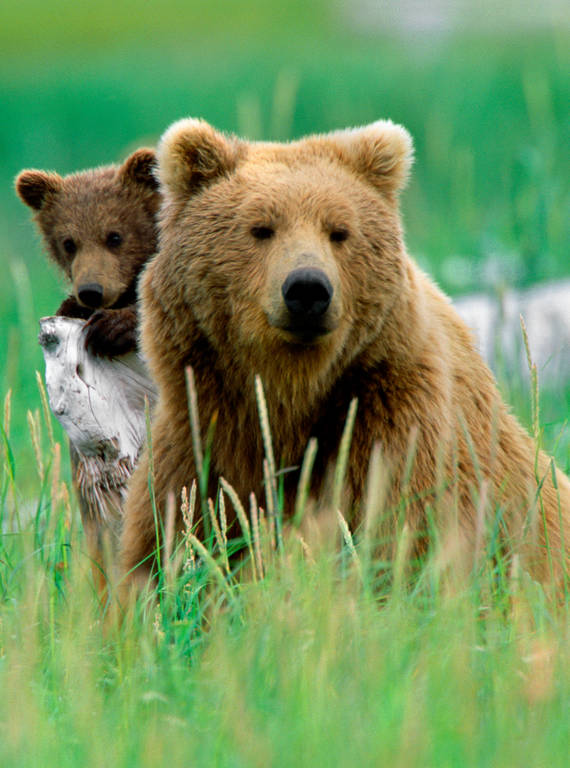5 reasons NPCA supports the Grizzly Bear Restoration Plan recently announced by the National Park Service and U.S. Fish and Wildlife Service.
Americans love our national parks because they are spectacular places where wildlife can thrive in abundance. The North Cascades is one of North America’s premier intact ecosystems, but it is incomplete without grizzly bears.
In a major move for national parks and wildlife conservation, the National Parks Service and U.S. Fish and Wildlife Service recently shared a draft plan to restore grizzly bears to North Cascades National Park and the surrounding wild lands in Washington state. Late last year, the federal agencies began a multi-year process to evaluate options for safely and successfully restoring and managing grizzly bears in this region where they once thrived. Although grizzlies roamed the North Cascades for thousands of years, the last grizzly confirmed in the park was over two decades ago.
The agencies’ environmental review has identified ways to support the bears’ recovery and safely manage bears in collaboration with surrounding communities. A previous process to explore restoring grizzlies to the region was abruptly halted by the last presidential administration in 2020, despite overwhelming public support to bring bears back to the North Cascades.
September’s announcement of the draft plan marks the start of the process to evaluate alternatives, with a public comment period that lasts through Nov. 13.
Here are five reasons NPCA celebrates the Grizzly Bear Restoration Plan:
1. North Cascades National Park and the surrounding ecosystem have more than enough open space to successfully recover grizzly bears.
The North Cascades ecosystem, located in north central Washington, totals more than 9,800 square miles of mostly protected public lands. It includes the national park, two national forests and several wilderness areas. This vast, remote and secure habitat is larger than Yellowstone, Glacier and Banff combined — all places with viable grizzly bear populations.
2. This would be a major step in restoring the species across its historic range.
Since 1975, grizzly bears have been listed as “threatened” under the Endangered Species Act. Despite recommending species augmentation for the North Cascades population in 1997, the Park Service did not have the resources to move forward with their plans.
Now the agencies have the resources and expertise to make this vision a reality, while addressing local community concerns. Restoration in the North Cascades will contribute to the greater recovery of the species across North America.
3. Grizzlies provide ecological benefits and will improve the ecosystem’s health.
Where grizzlies thrive, ecosystems thrive. These bears regulate populations of the animals they prey on and keep forests healthy by dispersing seeds and berries.

A grizzly and her cub in Alaska.
© Thomas D. MangelsenIn addition, they are expert diggers — their massive claws help aerate soils to facilitate wildflower growth. As grizzlies churn the soil, they create seed beds for flowering plants and grasses, and prevent conifer encroachment on both alpine and subalpine meadows.
Additionally, the population of bears on the Canadian side of the North Cascades ecosystem is considered critically endangered, and wildlife biologists do not believe a natural recovery is possible. Reintroducing bears on the U.S. side will complement significant efforts led by First Nations in Canada to bring back this sacred cultural species.
4. We’re giving grizzlies back their home — and people want that.
Grizzly bears roamed across the North Cascades for thousands of years as an essential part of the ecosystem. In the 20th century, however, people hunted, trapped and poisoned them to near extinction. According to the Park Service, the last confirmed sighting of a grizzly bear in the U.S. portion of the North Cascades Ecosystem was in 1996.
When a similar review process began in 2015, it received overwhelming public approval, with more than 159,000 public comments supporting restoration of grizzlies in the North Cascades. People from all 50 states spoke up in favor of returning grizzlies to their historic habitat. Grizzlies are one of the slowest reproducing land mammals in North America, so the sooner we begin supporting their repopulation, the better chance they have for long-term survival.
5. The public process includes new tools to reduce the potential for conflict with local landowners and communities.
The latest review process includes a 10(j) experimental population designation. According to the U.S. Fish and Wildlife Service, this designation for reintroduction of a species offers flexible, less restrictive management by authorities and landowners — benefiting people, property and bears.
For example, landowners may not be required to consult with the U.S. Fish and Wildlife Service as they manage lands that include grizzly bear habitat. The “experimental population” designation has been used successfully before in reintroducing species to their native habitats, such as the whooping crane in Florida and Louisiana and the gray wolf in New Mexico and Arizona.
This is a first step toward bringing balance back to the ecosystem and restoring a piece of the Pacific Northwest’s natural and cultural heritage.
When the process was announced last year, North Cascades National Park Superintendent Don Striker said, “This is a first step toward bringing balance back to the ecosystem and restoring a piece of the Pacific Northwest’s natural and cultural heritage. With the public’s help, we will evaluate a list of options to determine the best path forward.”
Gordon Congdon, a retired fruit orchardist and past director of the Chelan-Douglas Land Trust, agreed. His family has lived near the national park for three generations.
There’s a lot of interest from folks all over the state and the country because the grizzly bear is such an important, iconic and charismatic animal and it’s the only native large mammal absent from our wild lands.
“We’re cautiously optimistic that this process will lead to a decision on how to successfully restore grizzly bears to the North Cascades through sound science and robust public involvement,” said Congdon, who has been interested in land and wildlife conservation throughout his life.
Stay On Top of News
Our email newsletter shares the latest on parks.
“There’s a lot of interest from folks all over the state and the country because the grizzly bear is such an important, iconic and charismatic animal and it’s the only native large mammal absent from our wild lands.”
NPCA, too, is hopeful that this public process will lead to the restoration of grizzlies in North Cascades National Park within our lifetimes. It is an opportunity to make progress for wild places — to restore the last missing piece of the park and the broader ecosystem. The public is invited to weigh in as the agencies develop their final strategy on grizzly reintroduction in the region.
About the author
-
 Graham Taylor Senior Program Manager, Northwest Region, Northwest
Graham Taylor Senior Program Manager, Northwest Region, NorthwestJoining the Northwest Regional Office in the summer of 2015, Graham stays busy connecting people to parks in his role as Senior Program Manager.
-
General
-
- NPCA Region:
- Northwest
-
Issues

